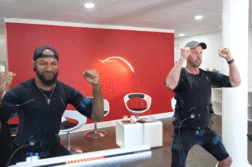ORLANDO, FLA. (Ivanhoe Newswire) — October is National Breast Cancer Awareness month – a perfect time to educate yourself about the disease that impacts one in every eight women in the US. But there are a lot of fallacies when it comes to this common cancer. Breast cancer myths
Kristen Lyons, Breast Cancer Survivor said, “I just, I felt something, and I thought, huh, it was real tiny, but it just felt different.”
“I didn’t think anything of it because of my age, and I found blood in my bra.” Says Breast Cancer Survivor Roshni Kamta.
Kristen and Roshani are two in three-point-eight million breast cancer survivors living in the United States.
Though there’s a lot of awareness – there’s also a lot of false information floating around.
Our first myth: You must have a lump to have breast cancer!
The truth is many cancers are found on mammograms that may not be felt. And not all lumps are bad – in fact, 80 percent of breast lumps that are biopsied are not cancer!
Another claim: you’re not likely to get breast cancer if no one in your family has it. The truth is only about five to 10 percent of breast cancers are caused by genetic mutations. And do mammograms always catch breast cancer? Studies show mammograms miss about 20 percent of breast cancers at the time of screening! And having dense breast tissue makes it more difficult to spot and raises your risk for breast cancer by two to four times.
“It just makes it more difficult for the radiologist to pick up any smaller tumor, if it’s present there.” Says Oncologist & Hematologist, Tricia Morino
You may have heard that a mastectomy is a better option than a lumpectomy, but this is also false in many cases. Recent studies have shown survival after a lumpectomy combined with radiation is equivalent to that of a mastectomy for most early-stage breast cancers. Setting the record straight when it comes breast cancer.
Other common myths: bras with underwire, nipple piercings, and deodorant will cause breast cancer. There’s no scientific proof that any of these will increase your risk. Some things that have been linked to breast cancer risk are using some forms of hormone replacement therapy for more than five years and drinking excessive amounts of alcohol.
Sources:
https://www.cancer.org/cancer/breast-cancer/about/how-common-is-breast-cancer.html
https://www.ivanhoe.com/family-health/breakthroughs-in-breast-cancer/
https://www.ivanhoe.com/family-health/women/breast-cancer-in-your-20s/
https://www.cancer.org/cancer/breast-cancer/about/how-common-is-breast-cancer.html
https://www.cdc.gov/cancer/breast/basic_info/risk_factors.htm
https://www.stopbreastcancer.org/information-center/myths-truths/
Contributors to this news report include: Julie Marks, Producer; Roque Correa, Videographer and Editor.
To receive a free weekly email on Smart Living from Ivanhoe, sign up at: http://www.ivanhoe.com/ftk



